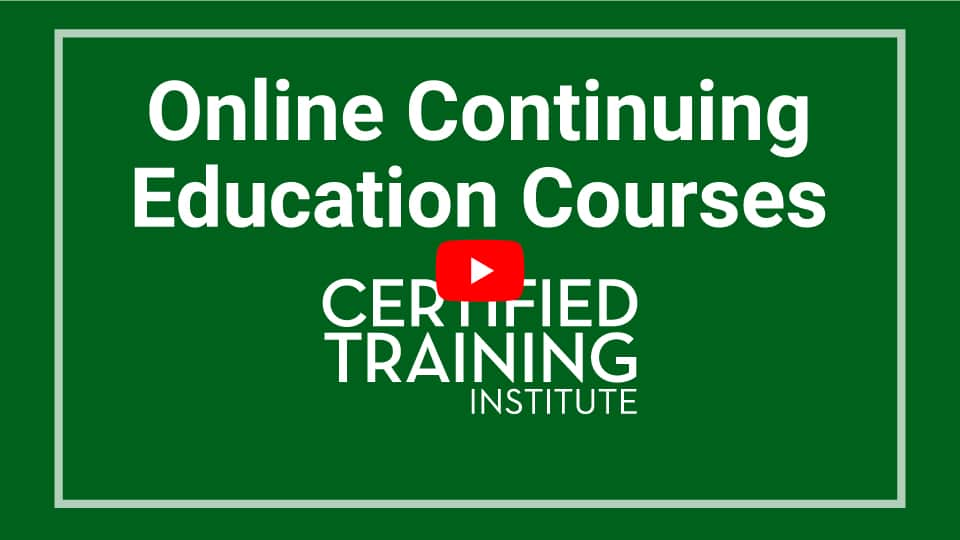Pesticide Applicator Continuing Education
Each course includes an official certificate of completion that you can save for your records. Looking for state reporting information? Learn more here.
Renewal Deadline: Applicators, Field Representatives, and Operators are required to renew their certification every three-years by June 30th.
CE Requirements: Continuing education hours differ by certification type. See chart for details.
» View California SPCB Applicator Continuing Education Requirements
All applicators are required to renew their certification by June 30th every three years. All continuing education credits must be completed no later than midnight on June 30th of their expiration year to count toward the credit requirement. Individuals who do not complete their CE prior to midnight on June 30th will need to re-test with the SPCB. Individuals are not required to submit certificates of completion with their renewal paperwork.
Applicator's Continuing Education Requirements
| Branch(es) Licensed | Total Hours | Rules and Regs | Pesticide Use and Application | Integrated Pest Management |
|---|---|---|---|---|
| Branch 2 (General Pest) | 12 | 4 | 6 | 2 |
| Branch 3 (Wood Destroying) | 12 | 4 | 6 | 2 |
| Branches 2 and 3 | 12 | 4 | 6 | 2 |
Field Representatives and Operator’s Continuing Education Requirements
| Branch(es) Licensed | Total Hours | Rules & Regs | Technical Branch 1 | Technical Branch 2 | Technical Branch 3 | Integrated Pest Management | General |
|---|---|---|---|---|---|---|---|
| Branch 1 (Fumigation) | 16 | 8 | 4 | - | - | - | 4 |
| Branch 2 (General Pest) | 16 | 8 | - | 4 | - | 2 | 2 |
| Branch 3 (Wood Destroying) | 16 | 8 | - | - | 4 | 2 | 2 |
| Branches 1 and 2 | 20 | 8 | 4 | 4 | - | 2 | 2 |
| Branches 1 and 3 | 20 | 8 | 4 | - | 4 | 2 | 2 |
| Branches 2 and 3 | 20 | 8 | - | 4 | 4 | 2 | 2 |
| Branches 1, 2, and 3 | 24 | 8 | 4 | 4 | 4 | 2 | 2 |
Applicator Complete 12 Credit Bundle
This course bundle is designed for the structural applicator in California. All courses are approved by the SPCB. Credits include 4 credits of rules and regulations, 6 credits of Pesticide Application and Use (PAU), and 2 credits of IPM training. Please click on course details for a detailed list of courses.
» View Package Content » Course Details
Rules & Regs 8 Credit Bundle
This course bundle is designed for all Applicators, Field Representative or Operator in California who need 8 credits of Rules and Regs. All courses are approved by the SPCB.
» View Package Content » Course Details
Technical Branch 2 and 3 Complete 20 Credit Bundle
This course bundle is designed for the Technical Branch 2 and 3 Field Representative or Operator in California. All courses are approved by the SPCB. Credits include 8.5 credits of rules and regulations, 4 credits of Technical Branch 2 training, 5.5 credits of Technical Branch 3 credits, and 2 credits of IPM training. Please click on course details for a detailed list of courses.
» View Package Content » Course Details
Technical Branch 2 General 8 Credit Bundle
This course bundle is designed for the Technical Branch 2 Field Representative or Operator in California. All courses are approved by the SPCB. Credits include 8 credits of rules and regulations, 4 credits of Technical Branch 2 training, 2 credits of IPM training, and 4 credits of general training. Please click on course details for a detailed list of courses.
» View Package Content » Course Details
Technical Branch 3 Complete 8 Credit Bundle
This course bundle is designed for the Technical Branch 3 Field Representative or Operator in California. All courses are approved by the SPCB. Credits include 5.5 credits of Technical Branch 3 training, and 2 credits of IPM training, and 2 credits of general training.
» View Package Content » Course Details
Bed Bugs: Overview and Management
This course looks at the history of bed bugs, current integrated pest management approaches to preventing and managing an infestation, and several of the chemical options available when your non-chemical controls and methods have failed.
Cage Trapping Techniques
This course focuses on the use of cage and box traps in the management of vertebrate pests in both urban and suburban environments. Best practices surrounding appropriate traps for target animals, effective baits, and safe and humane use of traps will be outlined.
Common Pests of Residential, Industrial & Institutional Structures
This online course teaches pest managers in California how to control interior and exterior pests that can damage various types of property, infect people, and negatively affect quality of life.
Disease Management in Enclosed Spaces
This course teaches the basics of pest and disease management in enclosed spaces where exposure is increased, and the different tools and techniques needed to successfully control the environment.
General Pesticide Use Safety
This course covers Respiratory Protection, Personal Protective Equipment & Emergency Response, Pesticide Application Procedures, Pesticide Formulations, Pesticide Hazards & First Aid, Pesticides in the Environment, Planning the Pesticide Application, and Transportation, Storage, Security, & Professional Conduct.
General Structural Pest Management
As certified or licensed professionals we have legal responsibilities that we must fulfill in every job that we do. Not only do have to control pests, but we also have to do the paperwork and legwork that documents our applications. This course reviews the basics of general structural pest management.
History of Integrated Pest Management
What is integrated pest management? The reality is nobody can agree on what integrated pest management is. This course will cover what IPM is and what isn't and how to be practical about IPM strategies.
Intro to Mosquito Control
This course discusses common methods of mosquito controls, everything from physical controls to pesticides, to record-keeping, all as part of a solid integrated pest management approach to mosquito control.
Intro to Mosquito Control and Management
Mosquito management is a daunting task for many applicators. When mosquito management is done incorrectly or isn't done at all, mosquitoes can make public spaces unusable. This course will discuss common methods of mosquito controls, everything from physical controls to pesticides, to record-keeping, all as part of a solid integrated pest management approach to mosquito control.
IPM for Termite Prevention
Termites are one of the most destructive pests in the United States. But there are several common-sense IPM practices that can be implemented to make a structure less inviting to termites from the start. This course will provide a review of IPM principles, termite biology, and several IPM practices to make any structure less attractive to termites.
Mosquito Management & Control
This course discusses common methods of mosquito controls, everything from physical controls to pesticides, to record-keeping, all as part of a solid integrated pest management approach to mosquito control.
Pest Control Practices in Residential, Industrial & Institutional Structures
Join this course to learn about controlling pests that can cause property damage, infections, injuries, or quality of life issues. As a structural pest manager, you'll learn safe, effective, and economical pest management methods while reducing hazards to yourself, others, and the environment.
Pesticide Labeling
The pesticide label is the main method of communication between a pesticide manufacturer and pesticide users. By law, pesticide users are required to comply with all instructions and use directions found on the pesticide product label.
Pesticide Laws & Regulations
This combined course covers Pesticide Labeling, Reading the Pesticide Label: Beyond the Basics, and Federal Pesticide Laws and will help you gain an understanding of labels, usage, safety data sheets, interpreting labels and online resources, identifying chemicals and brands, how to integrate important requirements, and how to maintain records.
Reading the Pesticide Label: Beyond the Basics
Labels are increasing in complexity and depth of information. It is never suggested that anyone try to memorize a pesticide label. By reviewing parts of a label and recognizing label language and use, we hope that you feel more comfortable with the information on pesticide labels and feel confident in understanding the information the present.
Respiratory and Environmental Protection with Emergency Management
California pest managers can use this course to learn the basics of safe and legal pesticide use. The course covers elements of safe handling and application, including management plans and alternative treatments, the types of respirators available, proper fit, and inspection/maintenance requirements. Learn best practices for public and environmental safety like notifying the public and posting warning signs.
Wood-Destroying Pest Management
Termites are just one of the many wood-destroying pests found throughout the United States. This course covers the primary wood-destroying pests found through the country, the recommended treatments for each of those pests, and the primary sources of excess structural moisture.

